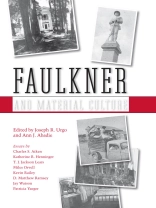Photographs, lumber, airplanes, hand-hewn coffins—in every William Faulkner novel and short story worldly material abounds. The essays in
Faulkner and Material Culture provide a fresh understanding of the things Faulkner brought from the world around him to the one he created.
Charles S. Aiken surveys Faulkner’s representation of terrain and concludes, contrary to established criticism, that to Faulkner, Yoknapatawpha was not a microcosm of the South but a very particular and quite specifically located place. Jay Watson works with literary theory, philosophy, the history of woodworking and furniture-making, and social and intellectual history to explore how
Light in August is tied intimately to the region’s logging and woodworking industries.
Other essays in the volume include Kevin Railey’s on the consumer goods that appear in
Flags in the Dust. Miles Orvell discusses the Confederate Soldier monuments installed in small towns throughout the South and how such monuments enter Faulkner’s work. Katherine Henninger analyzes Faulkner’s fictional representation of photographs and the function of photography within his fiction, particularly in
The Sound and the Fury,
Light in August, and
Absalom, Absalom!.
Om författaren
Ann J. Abadie (1939–2024) was associate director emerita of the Center for the Study of Southern Culture at the University of Mississippi as well as coeditor of numerous scholarly collections from the Faulkner and Yoknapatawpha Conference and other books published by University Press of Mississippi.












